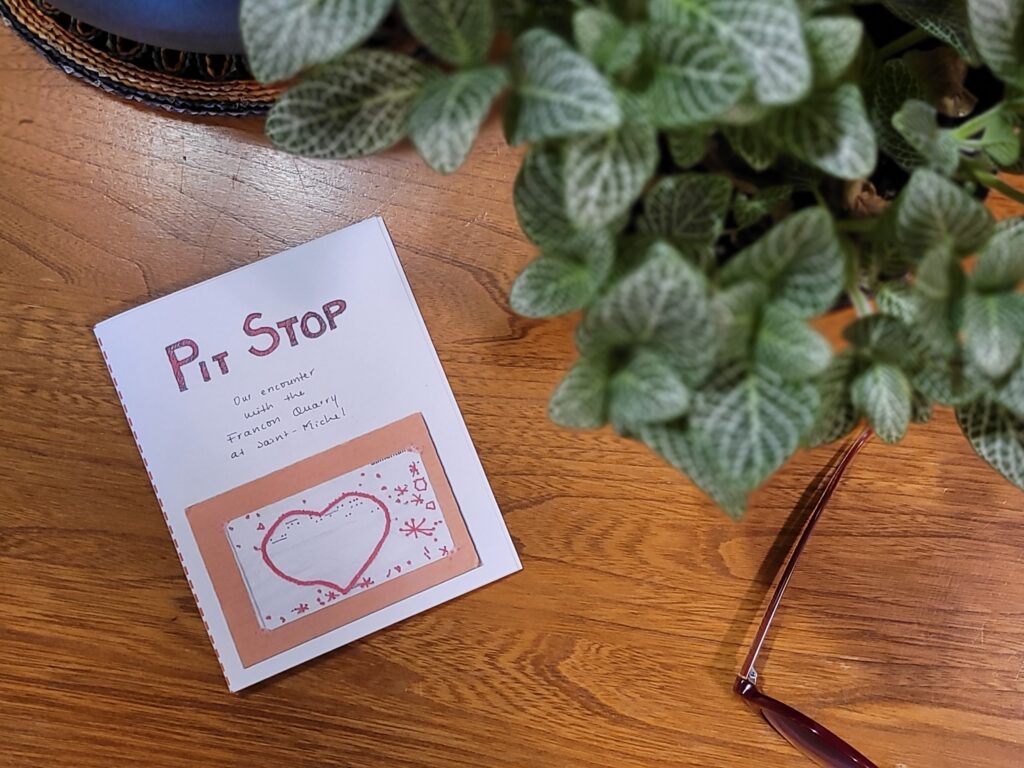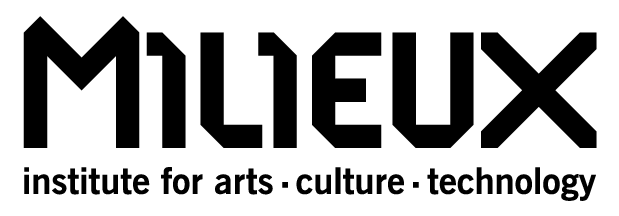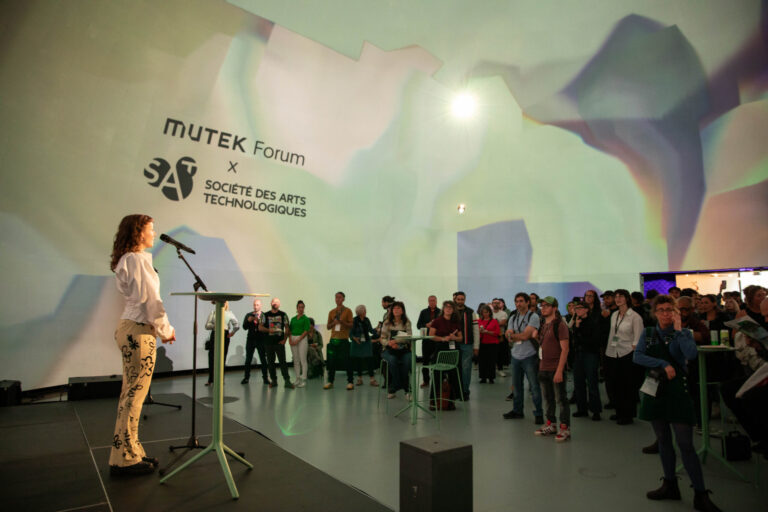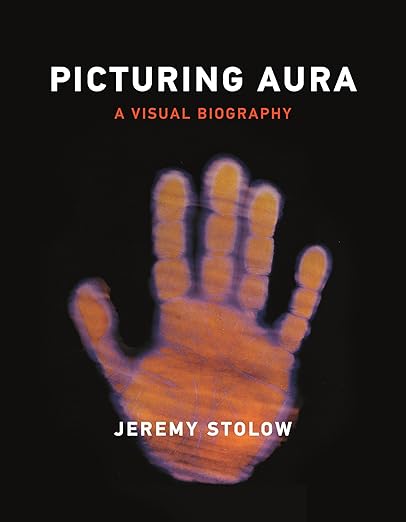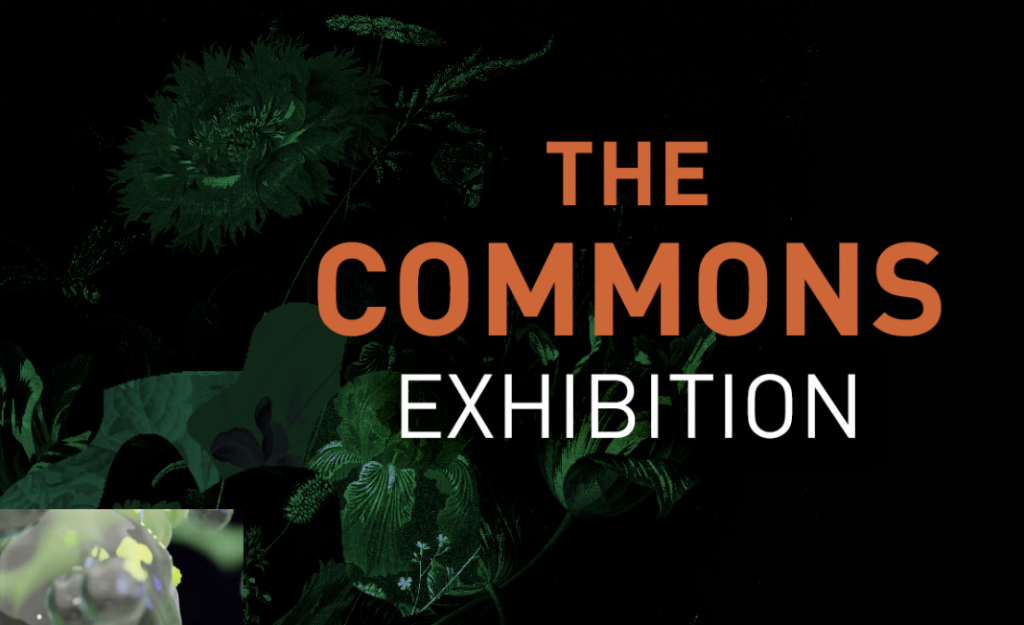We are incredibly excited to unveil the group of artists and researchers who will showcase their exceptional projects during the Milieux Institute’s members exhibition, The Commons, to take place from September 25th to the 29th, 2023, at Concordia University 4TH Space and the Concordia’s Video Production Studio (EV 10.760).
OPENING HOURS:
4TH SPACE | MONDAY – FRIDAY: 10 AM – 6 PM
VIDEO PRODUCTION STUDIO (EV 10.760) | MONDAY – FRIDAY: 12 – 5 PM
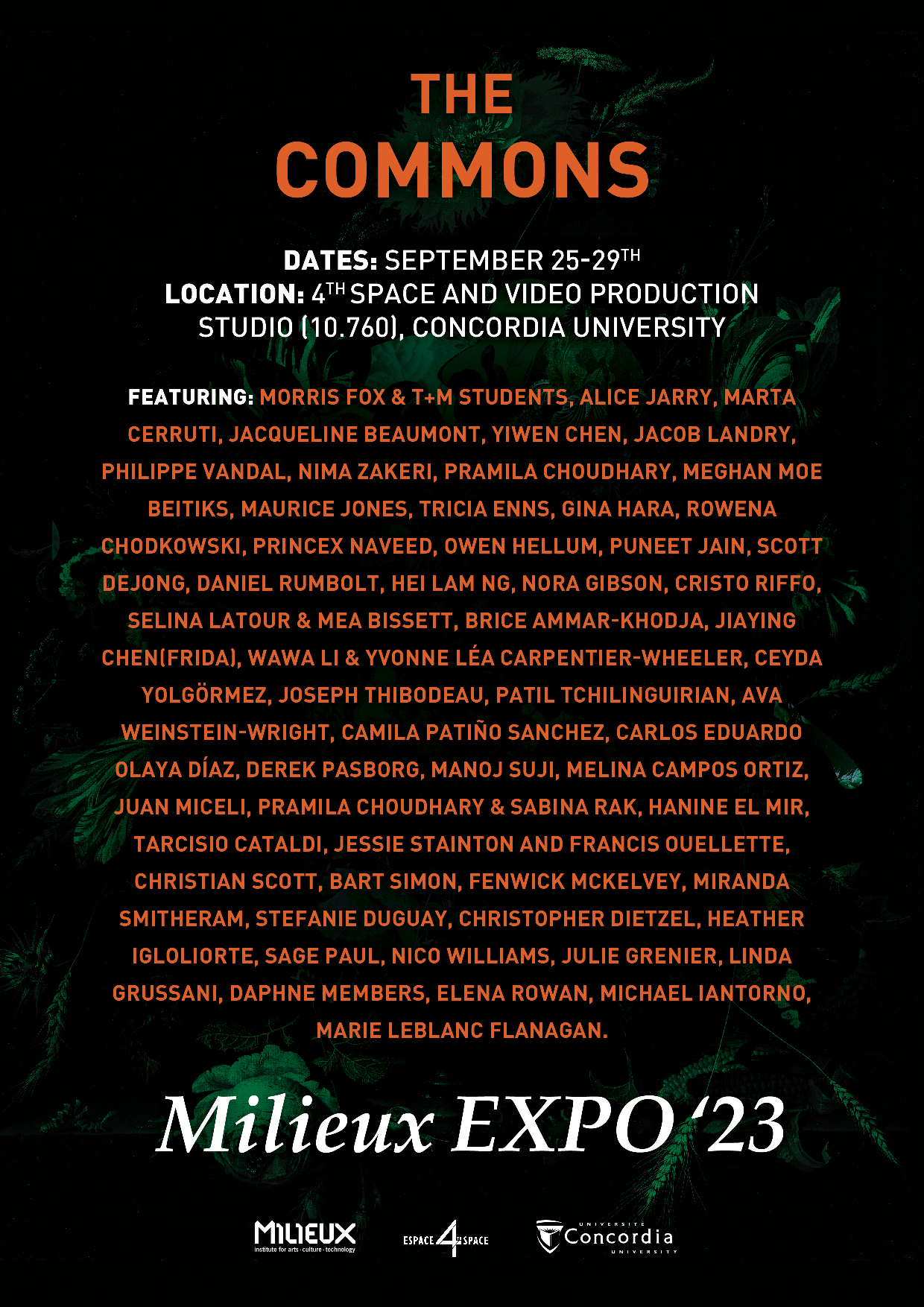
Chainstitch – Marc Beaulieu, Alexandra Bachmayer, Gen Moisan, Jacqueline Beaumont, Else Zavarce, Molly-Claire Gillett, Abby Maxwell, T Braun, Morris Fox, Dr. Miranda Smitheram
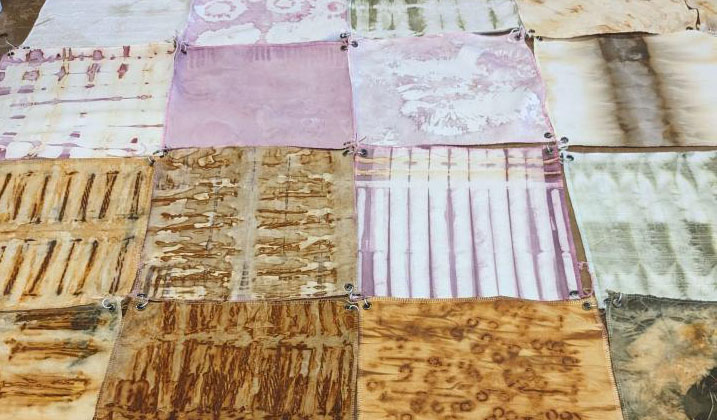
Textiles and Materiality Cluster’s participatory project Chainstitch, programmed by Morris Fox, combines collective action with individual research-creation to form a multimodal assemblage, delving into shared and hybrid research threads. This collaboration is an act of speculative community reciprocity, where tactile and tacit knowledge is braided from the materiality itself, like how a chain-stitch is decorative and utilitarian. Chainstitch entangles community dialogue and tactile emotional connections as living epistemes, not only as common cloth, but fragments of shared imaginations.
Reactive Graphene Oxide: New Materials and Collaborative Methods at the Interface of Design and Materials Engineering – Alice Jarry, Marta Cerruti, Jacqueline Beaumont, Yiwen Chen, Jacob Landry, Philippe Vandal, Nima Zakeri
At the crossroads of Design and Material Science, this research-creation project brings together scientists and artists to develop reactive membranes and objects using Graphene Oxide (GO). Graphene Oxide is a layered carbon-based nanomaterial derived from the oxidation and exfoliation of graphite, which can also be synthesized from thermal treatment of organic waste. Spanning multiple spatial, technical, artistic, and philosophical dimensions, the project addresses crucial questions at the core of current research in materials science and design: up to which point can materials mimic nature and become ‘alive’, changing themselves based on external stimuli? What happens when materials and humans interact? Can the interaction between materials and the environment help improve our own environment? Envisioned as a new generation of active materials for technological applications, the built environment and the arts, the structures developed in this project also aim to develop novel methods for arts and science collaboration and engage publics in a broader reflection on material futures and human’s shifting relationship with its environment in a context of ecological crisis. The co-creation process of this residency involves the presentation of a documentary film, in-situ prototyping, and ongoing video documentation of the work.
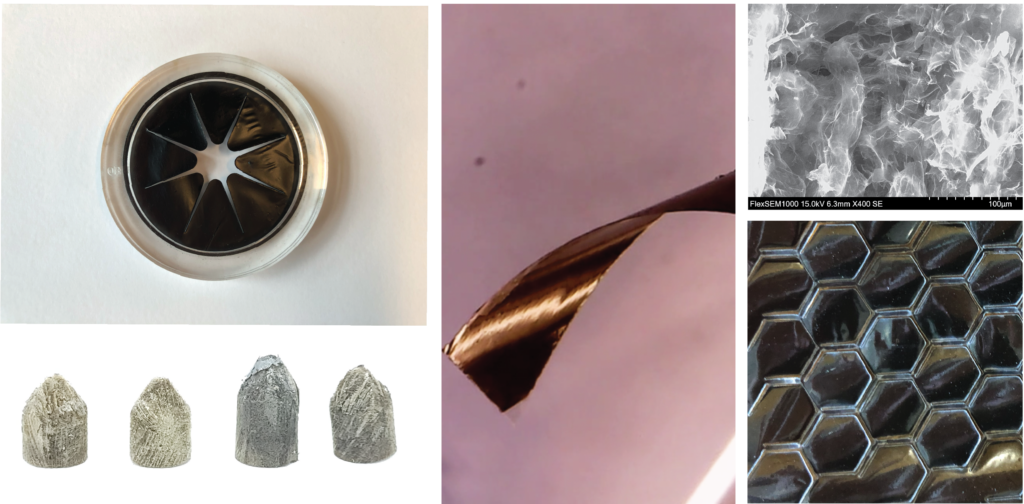
1134’s Silent Echo: Frozen Hands – Pramila Choudhary
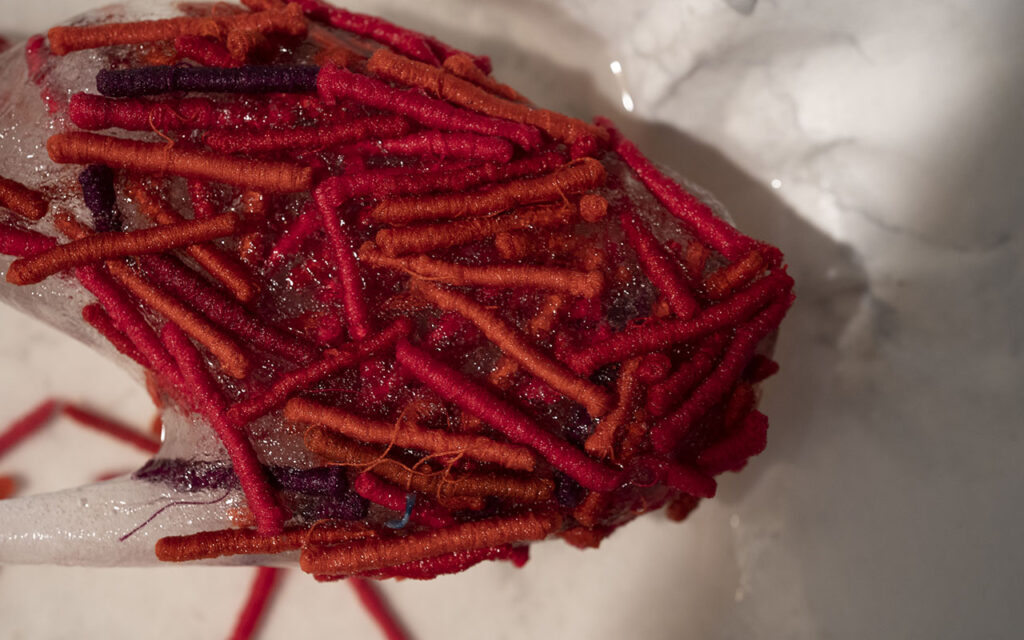
Frozen Hands: 1134 is an ongoing series that deeply reflects my odyssey as a textile designer. It begins with the reclamation of pre-consumer textile waste, sourced from fast fashion factories in India.
This venture sprang forth from my profound immersion in the realm of mass textile production. As a creator and designer, I was confronted with the staggering waste generated during material cutting and the various stages of production. The consequences of the fashion industry’s relentless pace began to unfold, affecting our environment, society, and water resources in profound ways.
The project takes its poignant title, 1134, in response to the tragic collapse of the ‘Rana Plaza’ building. Year after year, it serves as a solemn reminder of the pressing need to rein in overconsumption and the heedless pursuit of transient fashion trends. It is a resounding call to action, urging us to reevaluate our choices and their impact on our world.
Frozen Hands: 1134 casts a stark light on the dire consequences of excessive consumption. It unveils the vast mounds of discarded clothing that have metamorphosed Chile’s Atacama Desert into a haunting, desolate expanse. The majority of these garments are comprised of non-biodegradable materials like polyester, elastane, nylon, and acrylic—materials that persist for generations, far beyond our own lifetimes.
Join us on a journey through this ongoing series—a testament to the intersection of art, design, and a conscientious commitment to our planet. Through the tactile and visual narratives woven by Frozen Hands, we extend an invitation to contemplate the choices we make as consumers and the indelible mark they leave on the world.
Untitled (Desert Refractions) – Meghan Moe Beitiks
Untitled (Desert Refractions)(2021) is a sculpture, installation and performance created in response to the reflective glass surfaces of many Las Vegas Resorts, the desert environment, the arc of the sun, and the poem Ozymandias. The work explores reflection, opulence, sunlight, legacy, and the impermanence of power. Devised with local performers, the piece included both pre-recorded and live-streamed light as the Las Vegas sun set in real-time.
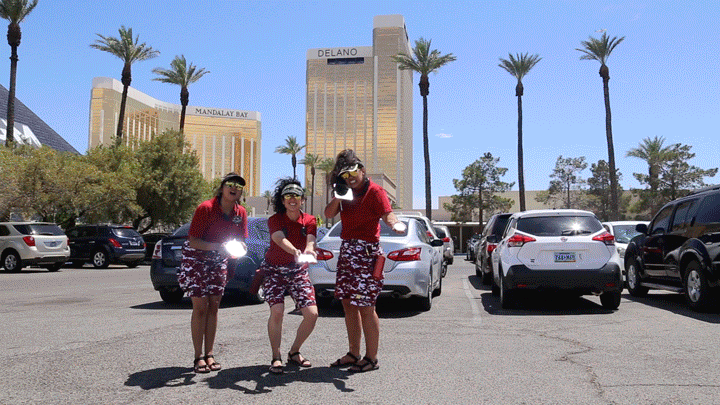
Soundscapes of an Earthly Community: Malachite – Maurice Jones
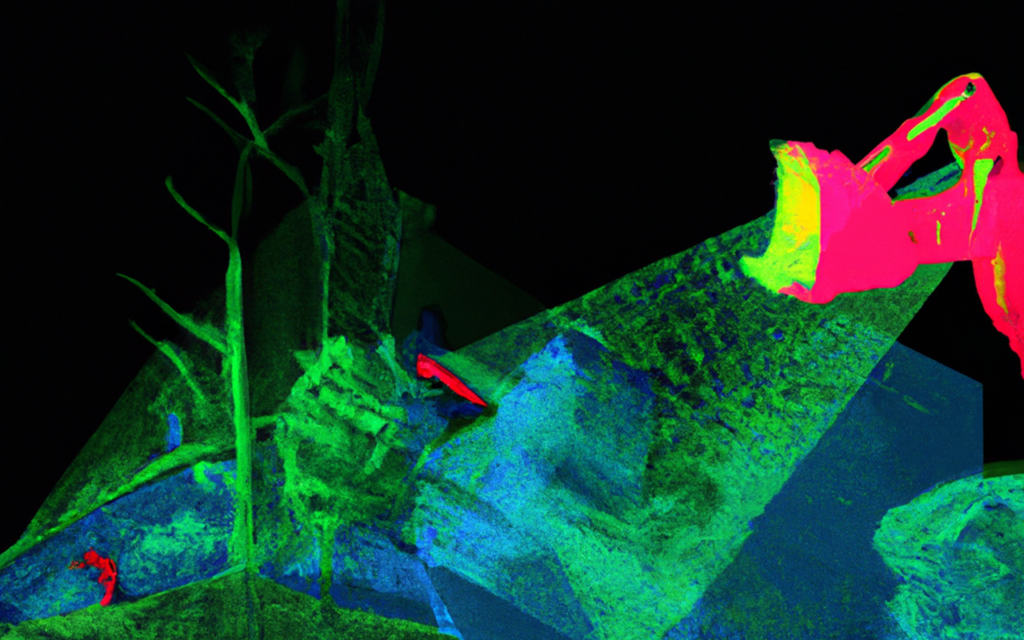
Malachite, a green copper mineral, is one of the earliest ores humans began mining. Copper is among the critical minerals, which are essential for our technological infrastructures including the green energy transition. Yet, extractive mining activities drive environmental degradation and the destruction of human and more-than-human communities.
Malachite symbolizes the inherent entanglement of technological advancements and ecological devastation at the heart of the current existential crisis humanity is facing. Technology destroys the very ecology it is constituted of. At the same time techno-solutionism is propagated as the cure for this self-generated crisis.
To address this most fundamental of issues Cameroonian philosopher Achille Mbembe calls for reenvisioning our more-than-human relations as an Earthly Community, which views humans and non-humans including nature and technology as co-inhabitants bound not by universality but by the in-common.
Soundscapes of an Earthly Community: Malachite sonically recreates the distress that mining activities put upon local environments and communities. Embracing Mbembe’s plea, the installation moves beyond existing trajectories to reenvision the cohabitation of humans, nature, and technology rooted in their in-common sonic character aided by the latest advancements in generative AI audio.
Vent Mapping – Tricia Enns
vent mapping is a research-creation project that explores the commons in relation to access to space and air in Montreal. Building vents represent breath: breathing humans and buildings, but also pollution that affects the commons of our city. Vent Mapping explores the hidden world of air within Montreal through the audio and video recording of building vents. The project provides another layer of understanding the city, through focusing on the hidden or unsightly, and critically observes how vents can affect us and others, through the sounds and potentially toxic air they emit. The project maps vents and then plays the audio of the vents together, as if in a confusing, noisy symphony. The project nudges the viewer towards the layers of the city that go unseen as we walk: the “unsightly”.
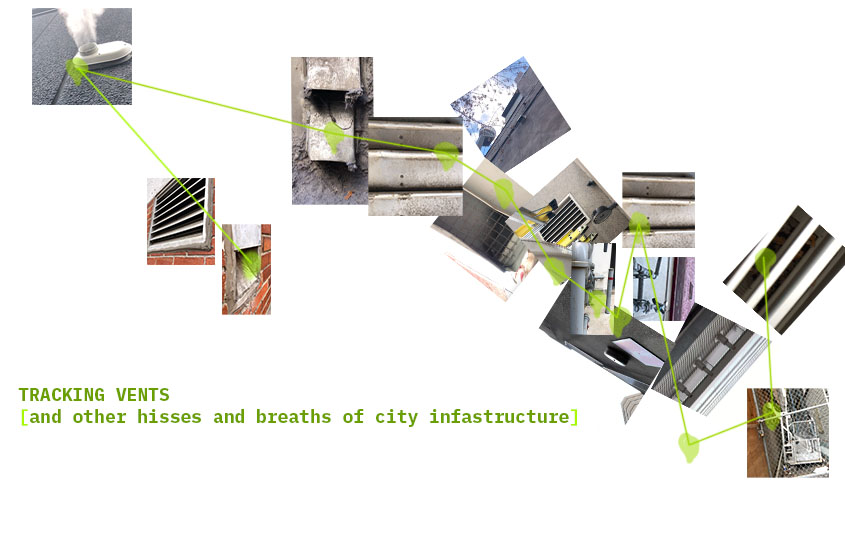
Machinima Bodies, Space, Rhythm – Gina Hara

Machinima Bodies, Space, Rhythm sets out to capture the current climate of machinima filmmaking from the point of view of women and non-brinary creators and allow viewers to immerse themselves in a physical representation of this liminal space in the form of a multi-channel video installation. Just like machinima is positioned inside the no-man’s-land (!) between various media, the installation will serve as an allegorical space to represent this. As viewers step inside the room surrounded by projected images of the interviews with well-known machinima filmmakers, they will also step out of the rest of the world and enter this immersive space of “otherness.”
but i’d rather be a pickle than a cyborg-goddess – Princex Naveed
but i’d rather be a pickle than a cyborg-goddess [2023] is a video installation that invites the to intimately bear witness to my transformation into a dill pickle. To me, the pickle is both mundane and highly meaningful, as it has emerged convergently in multiple ecologies I call home (Turtle Island, Eastern Europe, the Middle East). To pickle myself, I sensually and at times viscerally apply horseradish, dill, garlic, salt, and water on my half-naked body. Just like the opaque brine in a jar prevents the pickles from being seen from the outside, my body is never shown completely, and my face always remains hidden. Ultimately, this piece questions the modernist divide of nature versus culture, by looking back at the common ecology which gave birth to culture in the first place.
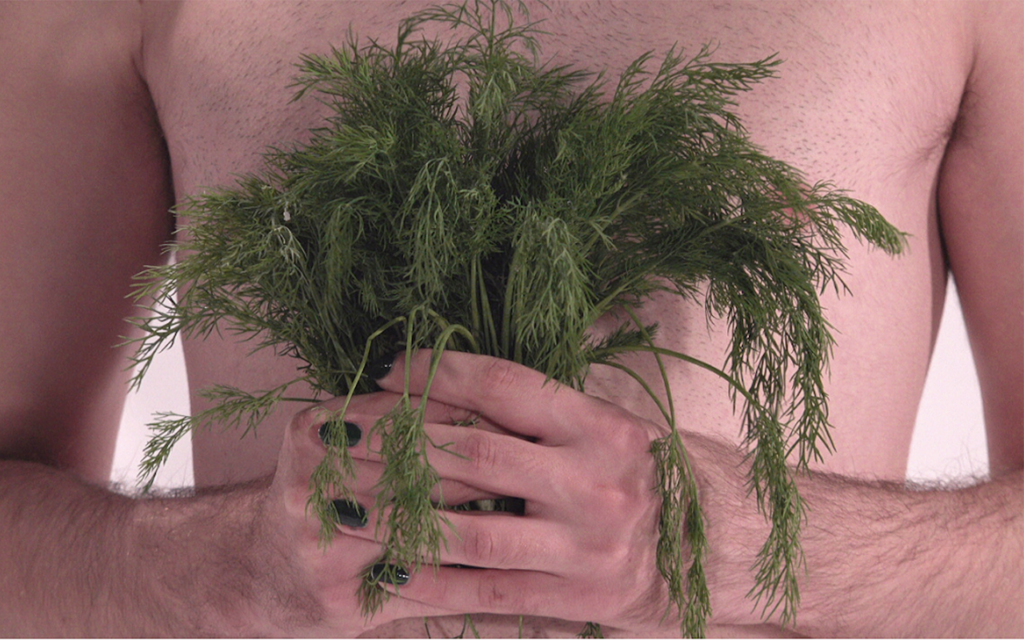
Revolutionary Retromimesis: A Stable Diffusion Model Trained on 70’s Chinese Comic Books – Rowena Chodkowski
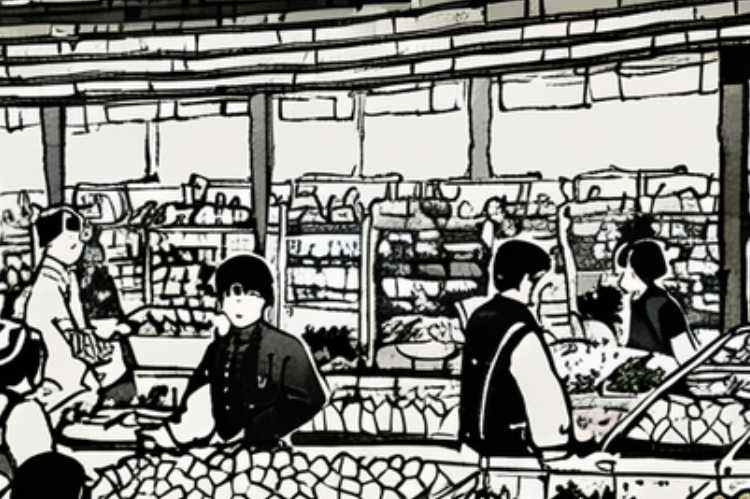
Inspired by Jason Lewis’s Future Imaginary course and Lawrence Lek’s Sinofuturism, this project is a Stable Diffusion model trained from an image set of over 2,000 images from 6 vintage Chinese comic books (1953-1986). These comic books recall an era of rigid, optimistic ideology and a time of deep national trauma. But they also reveal a moment of unprecedented mobility and the promise of modernity. These comics, with their dynamic illustrations and “true stories,” are the result of a revolutionary form of collective, mimetic cultural production in which what mattered as not the output or author, but the effect. This project, made using entirely open-source tools, revives that form of cultural production for the AI age. What possibilities will emerge when we use it to imagine for a pluralistic collective, collaborative life? Through an interface with suggested prompts, attendees can use the model to generate their own images and share them to an online gallery.
UNDERSCORE – Owen Hellum
UNDERSCORE is an experimental narrative game project that utilises environmental exploration, advanced non-linear dialogue, and multimedia to reflect on ideas of both alienation and kinship. Through engagement with many entities across three different acts, the player has the chance to explore concepts of shared suffering, understanding, and joy.
UNDERSCORE is an emotional work, pulling on personal experiences and thoughts in regards to shared feelings and shared hopes. The work was created in an attempt to explore concepts of choice and narrative through various academic definitions and classifications of game design. Through these novel approaches to classic narrative and game design scenarios (e.g. false choice, dilemma, delayed effect, etc.), a new approach is taken to the concepts of collective emotion and individual catharsis. This dense intertwining of both puzzle and story allow the game to effectively communicate its concepts of collectiveness.
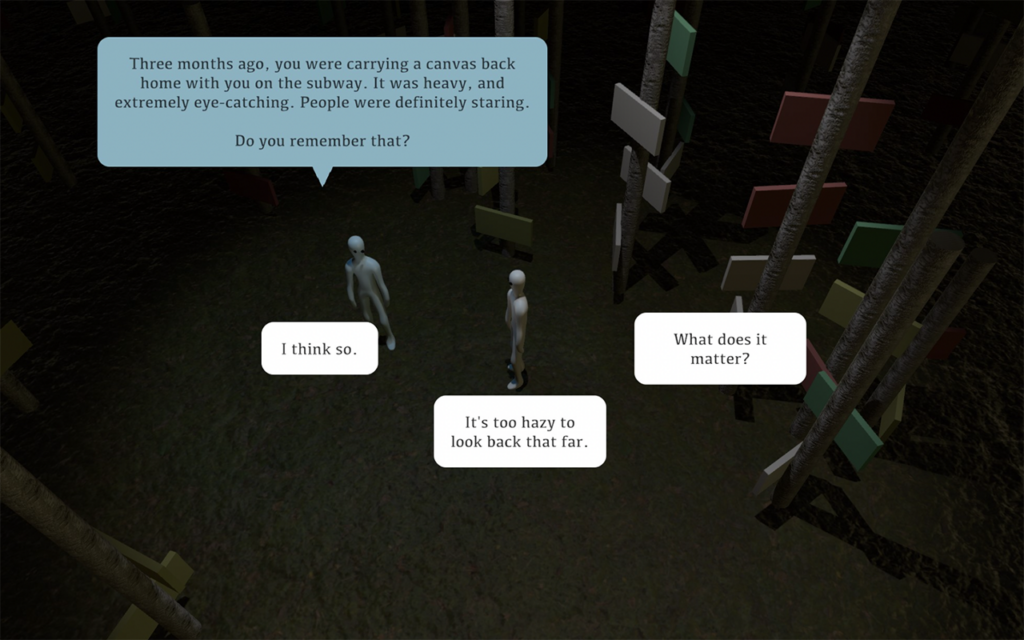
Dwell Time – Puneet Jain
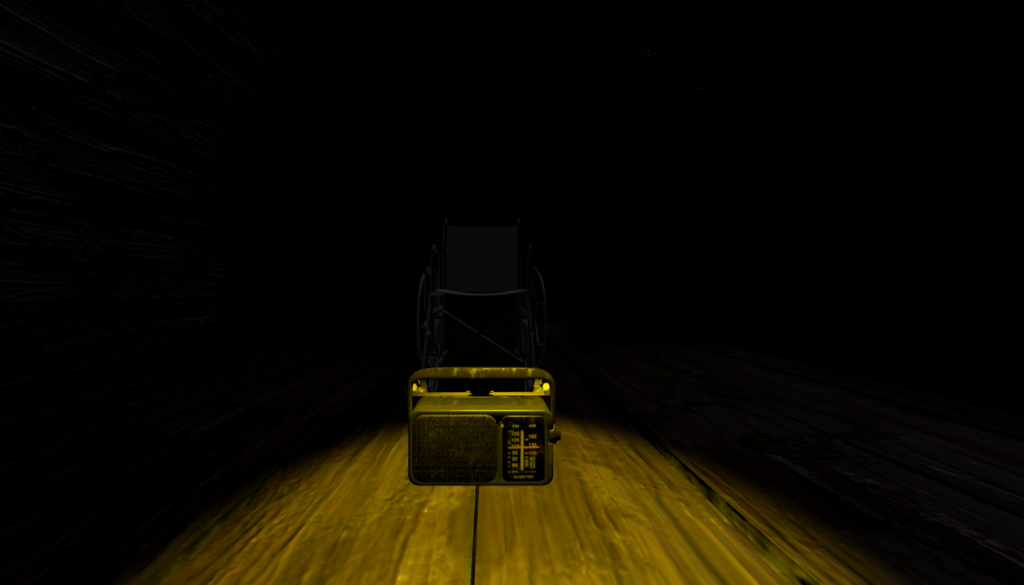
This project is an autobiographical poke at the borderlands of the ‘uncommon/common’ to reveal the “commons”. Drawing on my close interventions with students with sensorimotor disabilities in India, the proposed work is a self-reflection on my morphing practice as a non-disabled HCI researcher building assistive technologies with (and for) disabled people.
This project uses VR as a medium to multimodally to create a virtual space that visually, sonically, and haptically portrays the slowness, high-energy demand of bodily attention, access-intimacy (Mia Mingus, 2011), that I experience in my practice as I navigate in the shared-worlds of the disabled and the non-disabled.
The Rabbit Hole – Scott DeJong
Online disinformation has been likened to a game, and this project did so by turning research on Canadian disinformation into a playable fantasy game. Paying homage to the narrative adventure genre, this project uses its design structures and play to portray the research networks studied and provides an analogy and metaphor to the academic work conducted. Titled, The Rabbit Hole this project uses play to study and discuss how disinformation creates networks online. With a “mystical” codebook to break down the narrative, this exhibit shows the use of play-based practices in studying and relaying disinformation research. It raises questions around the power of narrative and analogy in creating online movements, as well as ways to visualize the deeply networked and convoluted dynamics of online misleading content.
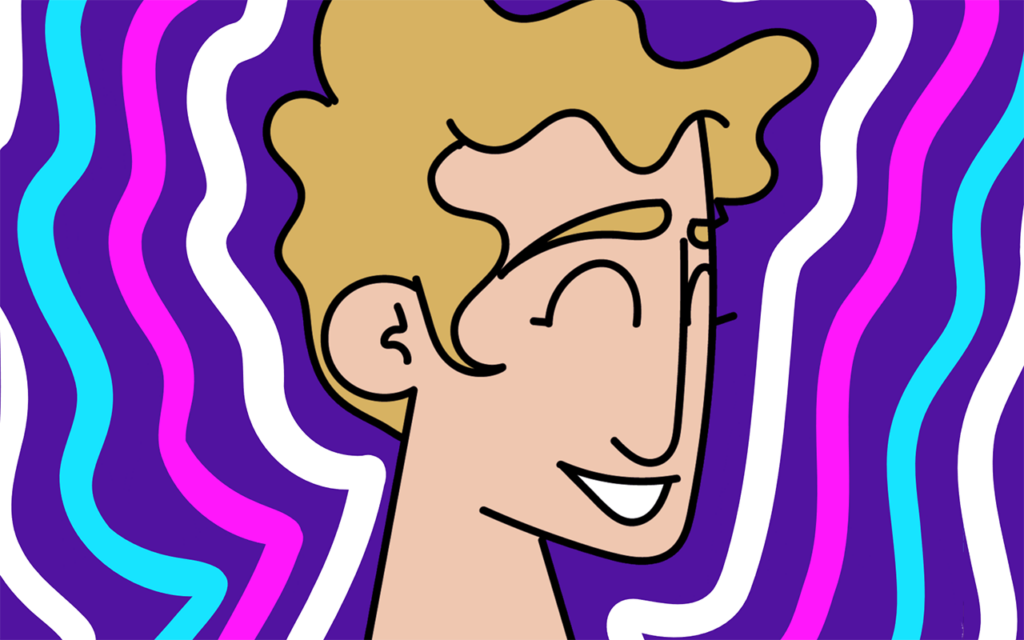
Grateful Adornment – Daniel Rumbolt
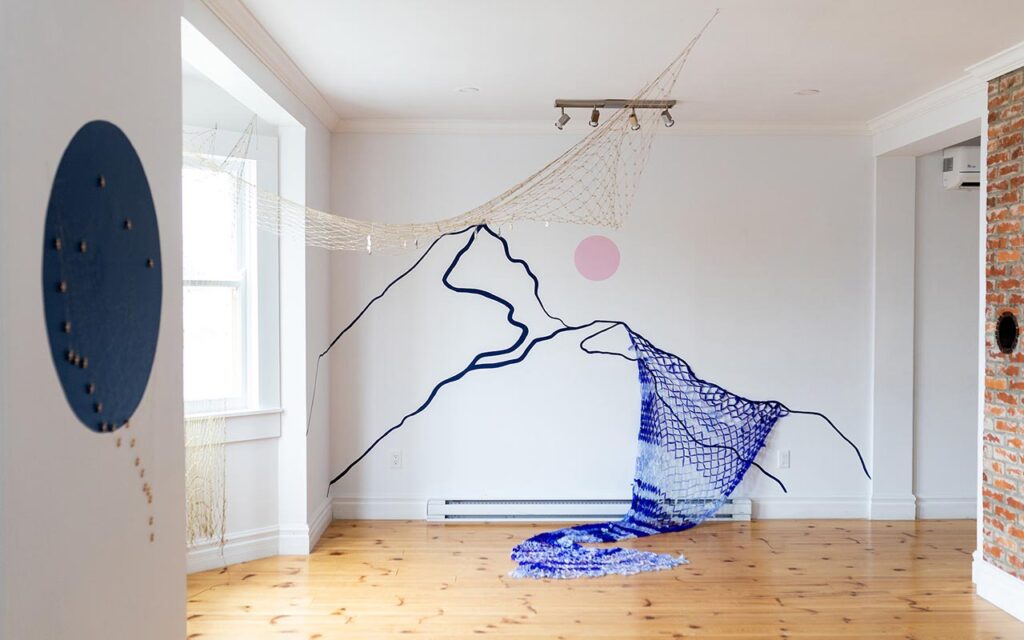
Net-making is a skill that is shared and valued, particularly in rural communities in my home province of Newfoundland and Labrador. It connects us to the land, and it keeps tradition alive in a place that relies on our own resilience and grit. The process is methodical and meditative, piercing a moment of time in your daily routine for contemplation and care. Silk ribbons drape and stretch to create the net, replacing what would often be nylon twine to further pull the scene from the coasts of Newfoundland and into my imagined reality of queer indulgence. They are gratefully adorned with pearls and gemstones, an offering to the place that shaped who I am, and to the person I am yet to become.
Strings of Whisper: Carnival – Hei Lam Ng
Strings of Whisper is a work in progress series of free-standing embroidery text of ambiguous content. Each piece consists 2-3 lines of words with a theme indicated in its title (carnival). This is a location-adaptive work which the strings of text can be suspended from the ceiling, gallery walls, corners, or curious spaces.
This work aims to give the view a quiet encountering of curious text, and take a moment to pause and listen to the whisper in the space.
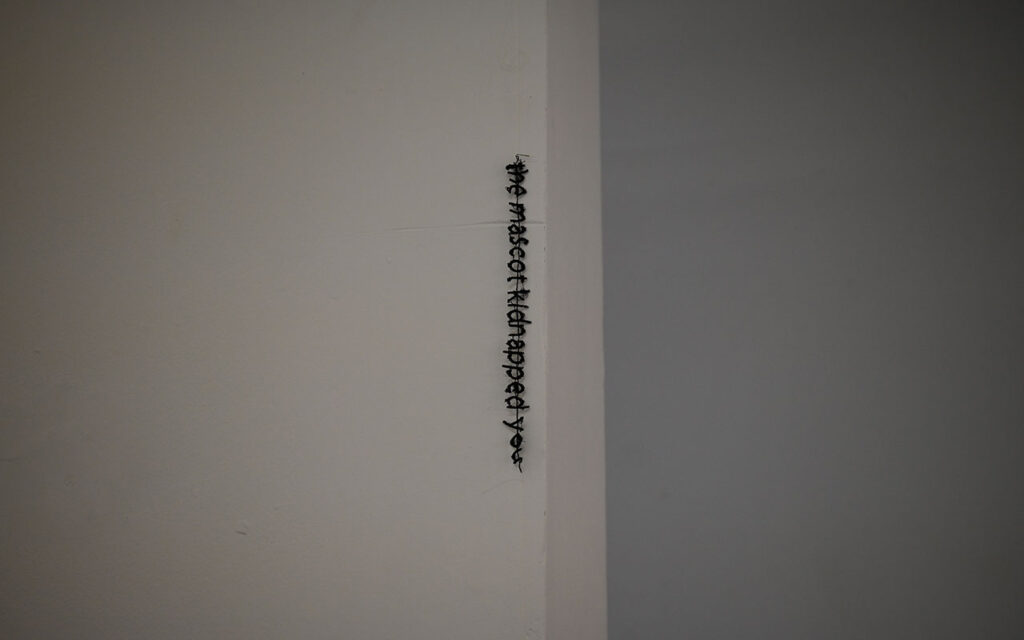
Non-Algorithmic Suite for the Transcendent Body – Nora Gibson
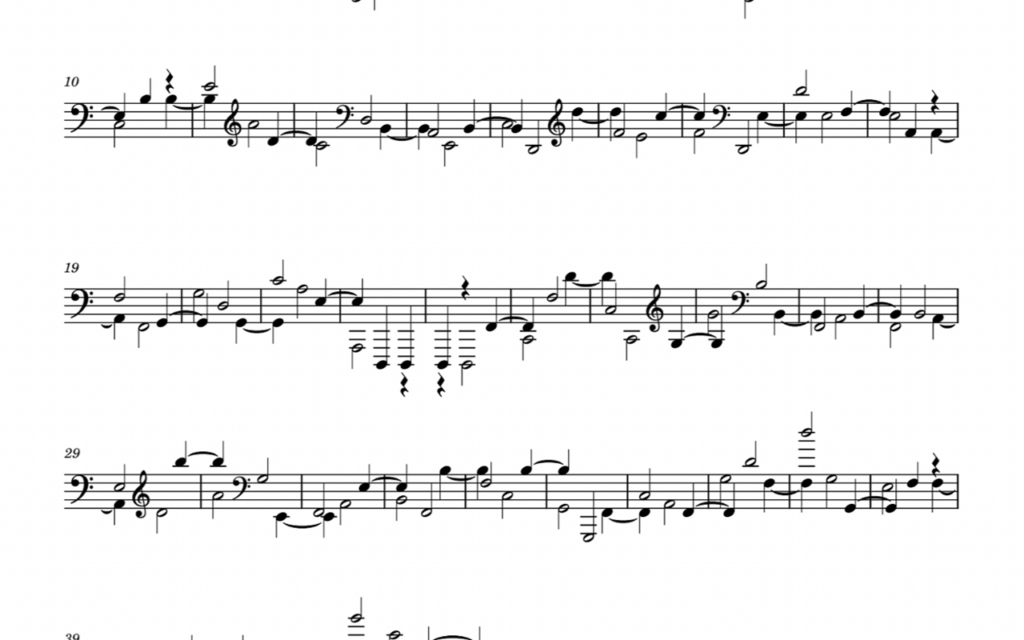
This suite of music is made from the physiological data generated from the artist’s body. Sensors captured gamma waves, electrical brain activity that is strongly correlated to consciousness, and heart rate data. This data was then translated to midi notes and sonified to create a musical score in a re-ideation of “body” that extends beyond its form.
This piece is structured in four contiguous movements: 1) dreaming and superpositioned realities; 2) the heart, it sings into an expanding space time; 3) the body is everywhere; 4) stars are conscious without cognition. Inspired by the emergent field of bio-quantum physics and the theory advanced by Roger Penrose and Dr. Stuart Hameroff, this work considers a common realm where consciousness arises. On display as well is the “gamma motif,” the musical score translated directly from the data through software and which forms the basis for the music.
Soil(s) Hunting Device – Brice Ammar-Khodja
Soil(s) Hunting Device explores how using an instrument inspired by navigation tools, such as a metal detector or dowsing rod, can trigger critical reflections on urban soil pollution. This instrument questions, on the one hand, the relationship between the art and design object and the public and how that same object can enable consideration of the sociopolitical and environmental dimensions of public environments.
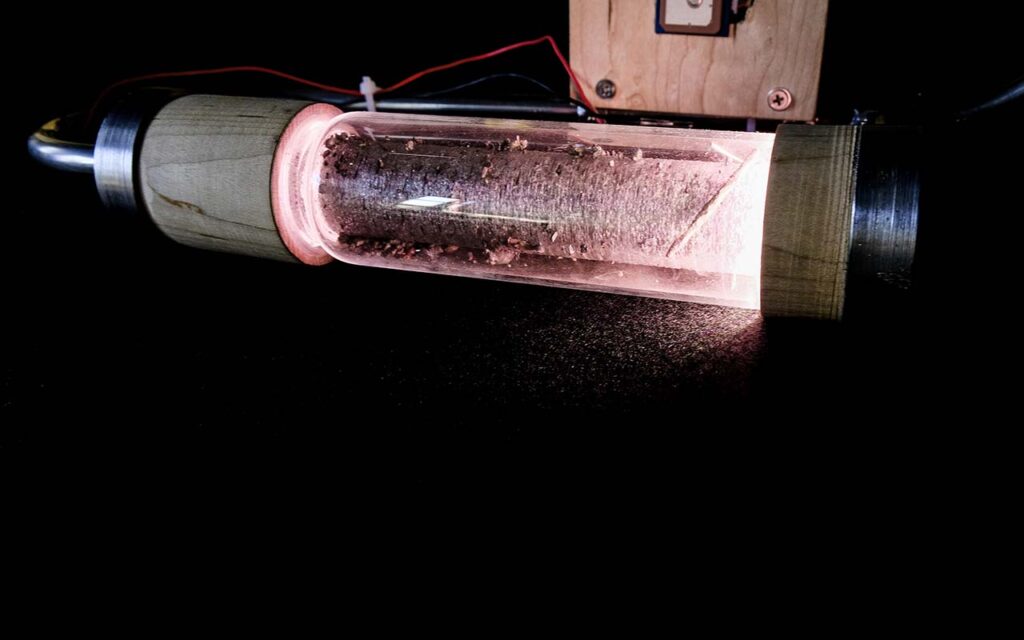
Cristo Riffo – Cultures
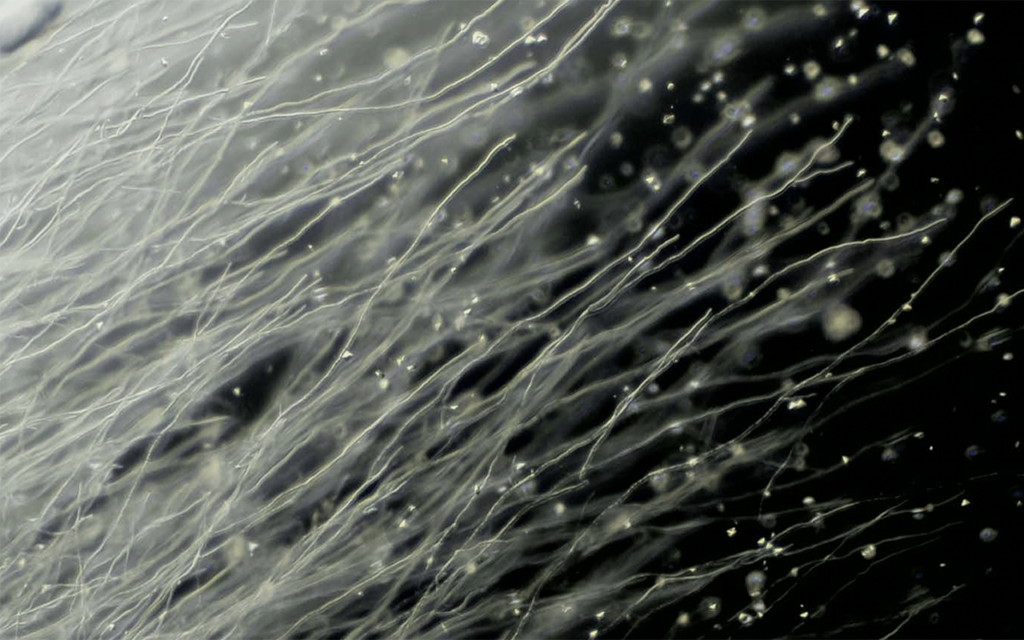
What are the hidden truths that we carry as migrants; the unspoken answers? This project seeks to explore this idea and connect it with the prehistoric past of microorganisms, the invisible beings that have migrated and changed with their environment for millions of years.
Cultures is a project that will be exhibited in two formats, part as a video projection and part as the display of the objects that were used for the creation of these videos. The project scopes to gather samples from objects that migrants brought from their home countries, swabbing these objects to produce cultures that will be grown in an incubator and recorded with the use of a hacked microscope.
Chasing Wind, Seizing Shadow: Be a Rhythmanalyst – Jiaying Chen(Frida)
Chasing wind and sezing shadow: be a rhythmanalyst (捕风捉影) is a transcultural photographic project across Taiwan, China, Sri Lanka, and Amsterdam. Inspired by the phrase “捕风捉影” (capturing wind and seizing shadow) in Chinese, it delves into the elusive qualities of rhythm in everyday life. Embracing Lefebvre, Deleuze, and Guattari, the project unveils affective landscapes beyond borders. Through photographs, it captures fragmented movements and implicit gestures, transcending language and cultural barriers. Engaging materialist readings, it invites viewers to become rhythmanalysts, exploring interconnectedness of materialities, subjects, and objects in rhythmic landscapes. “Capturing Rhythms” challenges narratives, embracing the universal language of rhythm and affective landscapes.

Communal Catalogne – Selina latour & Mea Bissett
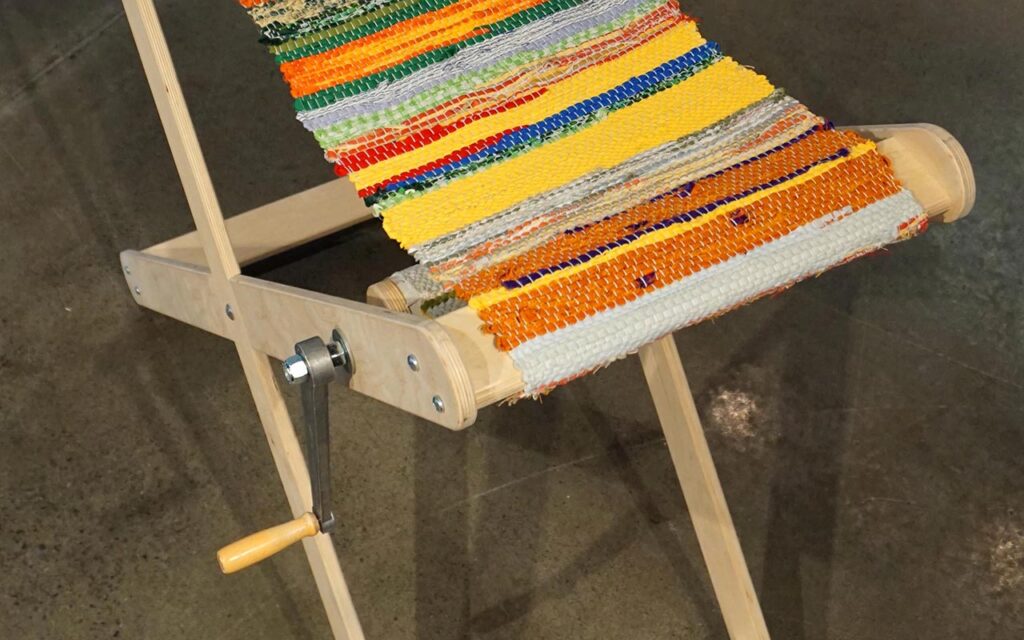
Communal Catalogne is a relational artwork that focuses on themes of sustainable craft, process-based creation and community building. Catalogne rag rug weaving is an historic Québecois vernacular craft technique that repurposes scrap fabrics to make functional rugs or blankets. In the summer of 2022, bissett and latour hosted a series of workshops on sustainable textiles and mending at the Pointe Saint Charles Art School. They transported a table loom and weaving materials around the PSC neighbourhood on a bike trailer provided by the Pedalbox Gallery. Stopping at parks, they invited passersby to participate by learning how to weave, and practicing on the rag rug. These workshops were educational and connected strangers through communal learning experiences and shared storytelling.
Wawa Li, Yvonne Léa Carpentier-Wheeler – Knives
The project proposed is an intimate and experimental documentary called “Knives” on the friendship between Dimitri and Wawa, their common fascination for swords and knives objects and the Chinatown neighborhood in which their friendship takes place. Dimitri, who is an intermittent inhabitant of the area, is visited by Wawa sporadically. Throughout their adventures, they encounter multiple characters, also residents of the neighborhood, which provide an insider portrayal of the complexity of the living conditions of the glamorized neighborhood.
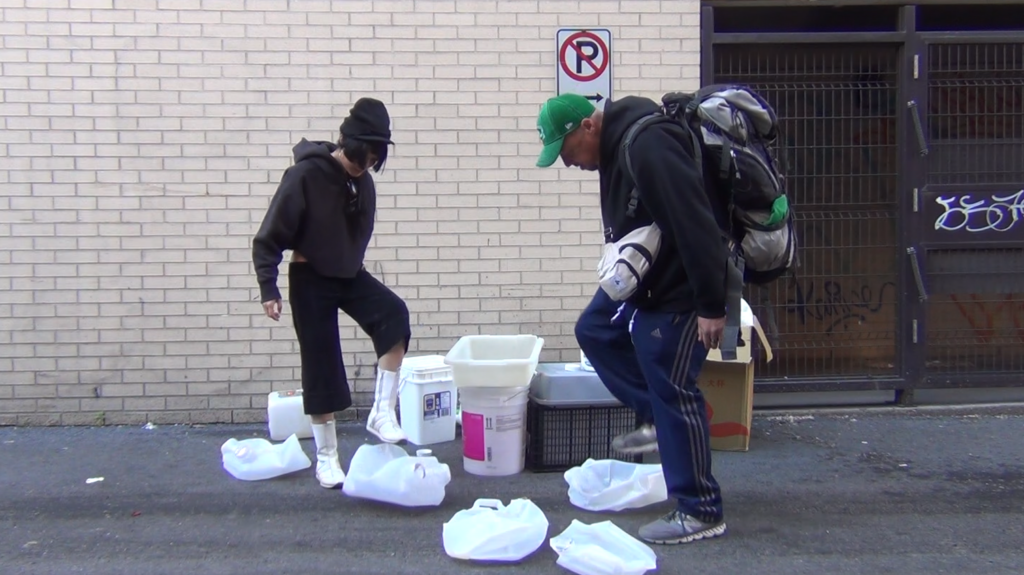
module 2: non-esg chaotic behavior – Philippe Vandal
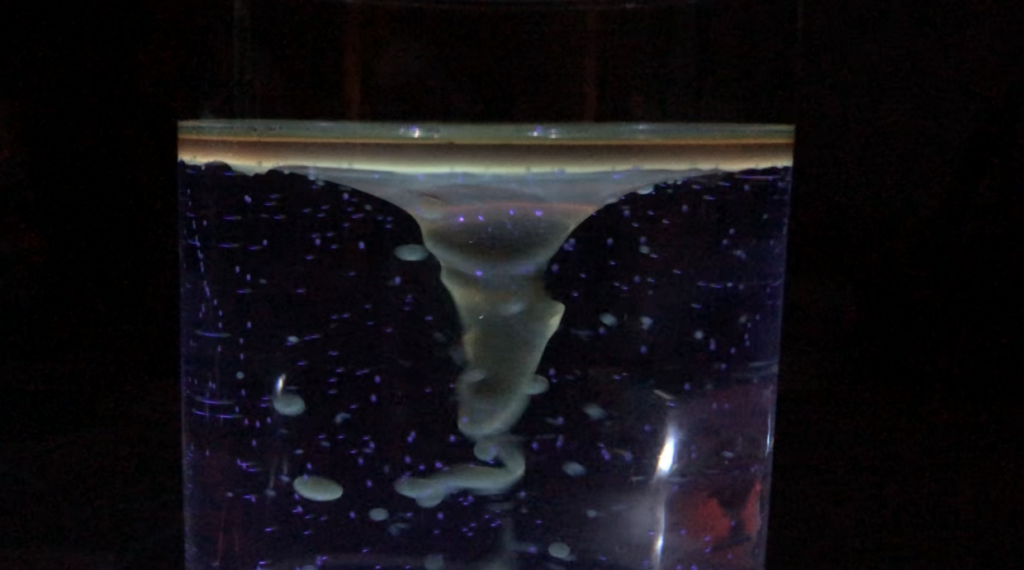
module 2: non-esg chaotic behavior consists of a combination of two magnetic stirrers that interpret the fluctuations in stock prices of Canadian banks and fossil fuel companies. Within glass beakers, a mixture of water and a thick amber liquid, symbolizing refined oils of different types, is present. The mesmerizing spinning motion of the magnetic bars, illuminated by ultraviolet LEDs, creates captivating patterns and reveals fluorescent shades. As the stocks fluctuate throughout the day, the movements become more intense, resulting in unpredictable gestures.
Technofossils – Juan Miceli
Technofossils is a ceramic installation that speculates about what will remain of us in the future and what is the relation between thinking and land. I depart from the very gesture of putting clay on my face as the building of the virtual and the double. I have made this pieces out of mixing EV Building’s mold archive, discarderd technology from CUCCR and both local and commercial clay. Thechnofossils is the word I invented to speak about the way poetic and technics are intertwined in our bodies and thinking. It belongs to Inverse Interface (i_), a transmedia-rhizomatic project that aims to recover the commons (spaces, practices and desires) by declassifying some embedded control matrices that support them.
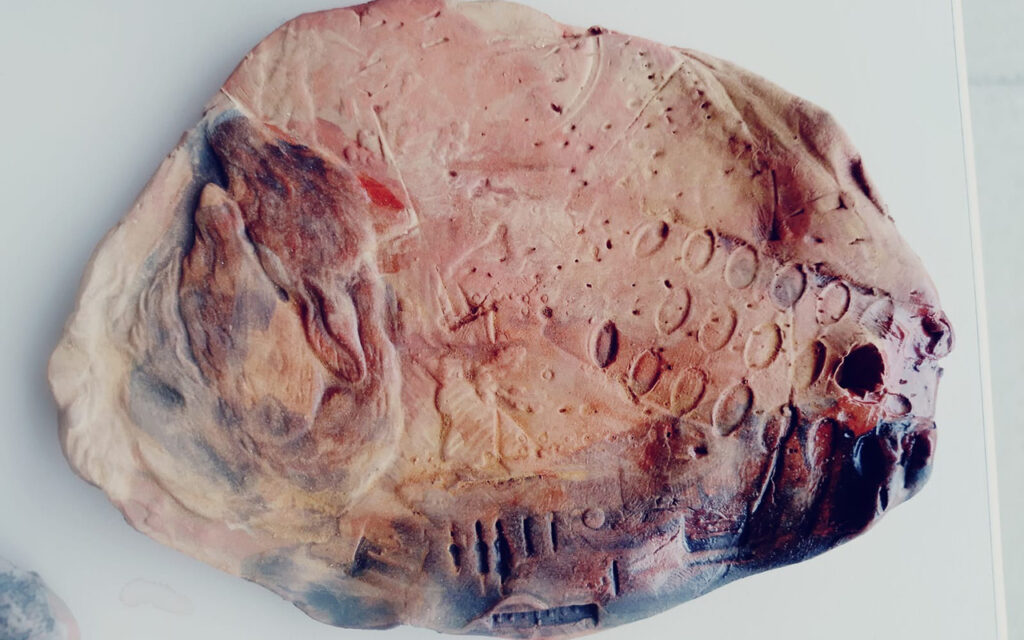
Human Circle: A growing pattern of collaborations – Pramila Choudhary & Sabina Rak

A 5-day public drawing collaboration on the idea of the circle. A universal symbol of both nothing and everything, of the individual and the universal, the circle stands here for the simplest form that, through addition and collaboration, can create an organic pattern. This is a proposed collective action, co-creation of one work of art mimicking the growth of an idea, of an organism, of shared interests into a larger, more cohesive whole. The project will also challenge the participants to rethink the idea of the circle and of the individual mark: how many ways are there to draw circles? Can you also stamp them, sprinkle them, fill them up, leave impressions, etc. A “circle sample book” will be made available to inspire. The materials provided will also encourage experimentation and discovery of what comes natural as mark making to each individual. Variety will only render the common result more surprising.
In Our Garden – Hanine El Mir
In Our Garden is a collaborative and cooperative board game in which players plant crops and maintain their gardens in order to feed their communities over the span of one year. Once a year has passed, the players may decide to expand on their individual soil plots, start a community garden, get a fridge, or participate in a farmers’ market. In Our Garden‘s playtime is based on growing times in seasonal farming calendars but scaled down for game optimisation. Players get an individual soil bed in which they plant seed cards, water them, and give them energy to help them grow. The main goal of the game is for players to achieve food security in their community. There are goal/quest cards to achieve that, such as “plant seasonally-available fruits, “plant 3 heads of garlic” and “plant only root vegetables for the next 3 turns.”

A Flag For Today – Tarcisio Cataldi
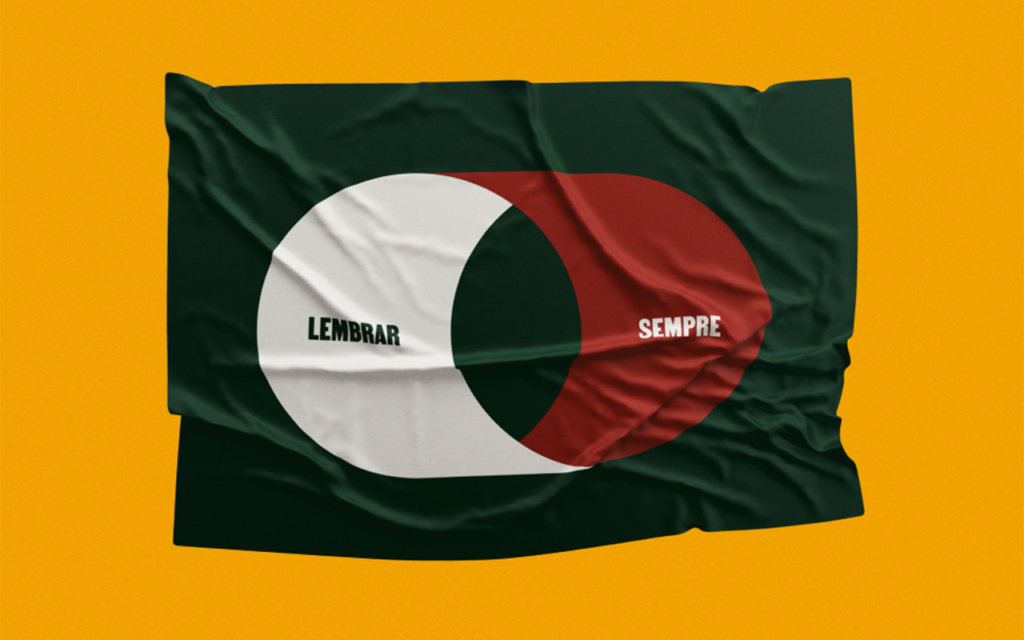
Beginning as forms of rudimentary signaling, flags have evolved through use in ancient military banners, to maritime semaphores, to symbols that represent entire nations and peoples. Considering its symbolic potential and thinking of flags as a visual platform for speculation, this project is an expansion of what a flag can be, whom it can represent and how symbolic meanings can be constructed.
This project consists of a textile, with a forest green background, a sewn symbol on it and the inscription “LEMBRAR SEMPRE”. The inscription is written in portuguese (native language of the artist) and it stands for “always remember”.
The Path is a Spiral – Jessie Stainton and Francis Ouellette
The Path is a Spiral is an installation exploring the relationship between isolated space and the effects of gentrification. Projecting a short film onto a rust-dyed textile piece, The Path is a Spiral is a visual narrative of a now inaccessible abandoned tunnel, previously a convenient venue for artists, musicians, and curious individuals.
Merging our practices, Francis as a filmmaker and Jessie as a textile-based artist, within the shared site of the tunnel, we create a textile piece dyed using discarded objects found at the site. We interject our documentation of this process with archival footage from the tunnel, resulting in a film that is then projected onto the suspended textile. In doing so, the mediums are caught in a continuous loop of interaction. Ultimately, The Path is a Spiral is an installation that encourages the viewer to reflect on how we relate to our environment and each other in the face of political polarity, climate crisis, and digital globalization.
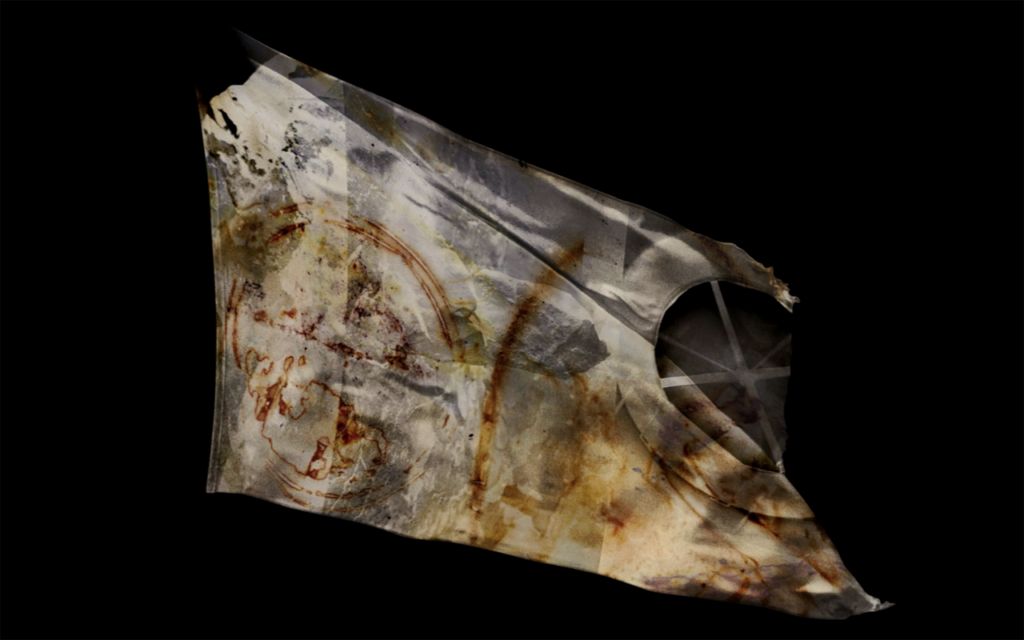
Robotic Adventures: NAO in Montreal – Ceyda Yolgörmez, Joseph Thibodeau, Patil Tchilinguirian
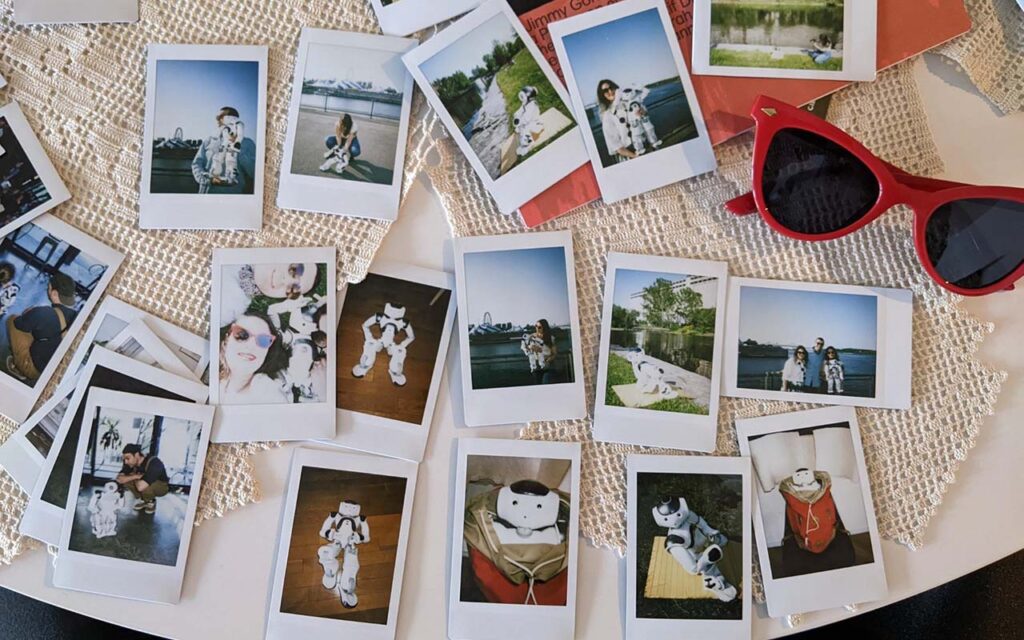
This research-creation project uses a critical and creative approach to understand and imagine human-machine relations. It takes the event of NAOs visit to Montreal as an occasion to grasp this machinic being through their everyday rituals. We invited NAO to our living spaces to live together, to “hang together,” to observe and participate in a sustained and persistent flow of interactions with them in the intimacy of everyday life. In the process, we are documenting and archiving how NAO presents itself in its everyday life and mapping how its materiality relates to the contexts of interaction. We center on the notion of the ritual both as a way to refer to the gestures and behaviors that emerge in the contexts of everyday interaction and also to liminal spaces that create the conditions for the emergence of social change. Ritual allows us to consider the role of performativity in the making of new social contracts, and so we approach this particular residency instance as a way to explore how we can ritualize care in human-machine relations. Ultimately, we approach NAO’s visit to Montreal as a site to grapple with the changing conditions of human-machine relations through participatory research methodologies. The residency is hosted by The Goethe-Institut Montreal and is in partnership with Milieux Institute, Hexagram, and Eastern Bloc.
Pit Stop : Our encounter with the Francon Quarry at Saint-Michel – Ava Weinstein-Wright, Camila Patiño Sanchez, Carlos Eduardo Olaya Díaz, Derek Pasborg, Manoj Suji, Melina Campos Ortiz.
The Francon Quarry, which we refer to as the Pit, is an enigmatic space at the heart of Saint-Michel borough of Montreal, often unseen despite its spectacular size. Its landscape, a post-extraction site that now receives almost half of Montreal’s snow, hides a history of dreamed and contested futures from geologists, corporations, and local activist communities. We approached this space as part of the Infrastructures of Ethnography project at the Concordia Ethnography Lab. We produced a zine inspired by a request from a community leader in Saint-Michel who told us “the way you could help us, is to visualize the possibilities”. Having that in mind, and following our lab’s composite ethnography methodology, we decided to trace our encounter with the Pit and the things we learned in the process of getting acquainted with the Francon Quarry and the different futures associated with it. Our final aim is to share and sensitize locals and foreigners in an alternative manner about our mundane but profound connections with this site. Through the production of this zine, we also sought to enact care and fun as collaborative research methods in their own right.
